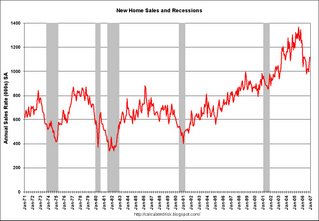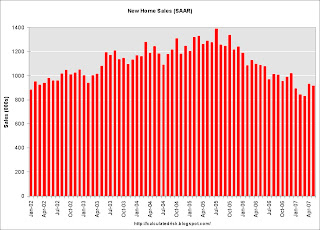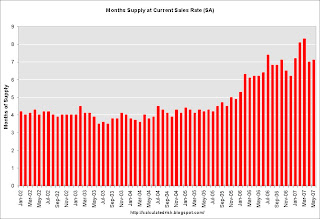by Calculated Risk on 6/26/2007 11:50:00 PM
Tuesday, June 26, 2007
LBO Debt Market Changing
From the WSJ: Bonds Becoming a Tougher Sale
Investors issued a resounding 'No' to a leveraged-buyout debt offering yesterday, leaving banks holding the bag for more than $3 billion and raising concerns about the changing economics of the takeover boom.From the NY Times: Delay in Buyout Bond Sale
...
Underwriters pulled a $1.55 billion bond offering by U.S. Foodservice, the nation's second-largest food distributor. The company also postponed plans to sell $2 billion in loans to fund the deal, according to people familiar with the matter. For now, the banks involved in underwriting the deal will have to lend the $3.6 billion directly to U.S. Foodservice, which is being bought from Royal Ahold NV of the Netherlands.
...
The pushback comes at a challenging moment. Investors are looking ahead at $250 billion of new debt coming to market in the coming months. Just this week, Chrysler Group, which is being sold by DaimlerChrysler AG, began marketing a debt fund raising that will total more than $60 billion.
This week, two other buyouts, the $4.7 billion deal for ServiceMaster and the $6.9 billion sale of Dollar General, are expected to price their bonds.It will be interesting to see what happens to these other bond sales. The WSJ noted that ServiceMaster reduced it's "payment in kind" feature, so maybe that sale will be OK.
S&P: Alt A Loans `Disconcerting,' Jumbos Weaker
by Calculated Risk on 6/26/2007 06:52:00 PM
From Bloomberg: Alt A Loans `Disconcerting,' Jumbos Weaker, S&P Says (hat tip risk capital)
U.S. homeowners with good credit are increasingly falling behind on mortgage payments, a sign lenders have been offering ``higher risk'' loans outside the so-called subprime market, Standard & Poor's Corp. said today.Is this the end of the word "contained"?
Rising late payments and defaults on so-called Alt A mortgages made last year are ``disconcerting'' and delinquent borrowers appear to be ``finding it increasingly difficult to refinance'' or catch up on their payments, S&P analysts said today in a statement. ``Serious'' delinquencies, foreclosures and seized property among ``prime jumbo'' mortgages in bonds from 2006 reached the highest among loans of less than 13 months since at least before 2000, S&P said in a separate report.
...
S&P, one of the two largest ratings firms, is now ``examining how the risk profile clearly increased'' in the Alt A market, it said in a statement sent by e-mail today. ``We will communicate our findings to the market,'' S&P said, in language it typically uses ahead of adjusting its rating methodology.
JPMorgan: Planned CDO Sales Dry Up Amid Bailout
by Calculated Risk on 6/26/2007 05:00:00 PM
From Bloomberg: Planned CDO Sales Dry Up Amid Bailout, JPMorgan Says (hat tip Brian)
Planned sales of collateralized debt obligations backed mainly by subprime mortgages are drying up and may shut down amid concerns about the integrity of the market following the near collapse of hedge funds run by Bear Stearns Cos., JPMorgan Chase & Co. said.No wonder Dr. Altig asks: What's That Unpleasant Sound?
The amount of U.S. high-grade, structured finance CDOs that are being offered to investors has plunged to $3 billion, from $20 billion a month ago ...
"We expect events surrounding warehousing liquidations last week to further slow, if not halt entirely, the new issue market," JPMorgan analysts led by Chris Flanagan in New York said in the report.
...
The damage to the $1 trillion CDO market could freeze what has been a large source of liquidity for the credit markets, Tim Backshall, chief strategist at Credit Derivatives Research LLC, said yesterday.
According to Lombard Street Research, it's a credit crunch. From the U.K. Telegraph:Altig is rightly skeptical of the report, but I do think the sector specific credit crunch is definitely getting more severe, and might expand to other sectors (like M&A loans and CRE investments).The United States faces a severe credit crunch as mounting losses on risky forms of debt catch up with the banks and force them to curb lending and call in existing loans, according to a report by Lombard Street Research.
More on May New Home Sales
by Calculated Risk on 6/26/2007 03:32:00 PM
For more graphs, please see my earlier post: May New Home Sales Click on graph for larger image.
Click on graph for larger image.
The first graph shows New Home Sales vs. Recession for the last 35 years. New Home sales were falling prior to every recession, with the exception of the business investment led recession of 2001. This should raise concerns about a possible consumer led recession in the months ahead.
For Fun: Here is the same graph after the December 2006 sales were reported just a few months ago. The housing bust was "over". Not! The bounce back was revised away.
Once again, this reminds us to take the "just reported" data with a grain of salt. As reported this morning, much of the surprise "bounce back" in April has already been revised away.
The third graph compares annual New Home Sales vs. Not Seasonally Adjusted (NSA) New Home Sales through April.
Typically, for an average year, about 44% of all new home sales happen before the end of May. At the current pace, new home sales for 2007 will probably be under 900 thousand - about the same level as the late '90s. This is significantly below the forecasts of even many bearish forecasters.
As a final note, this puts total reported inventory at a record 4.967 million units (4.431 existing homes and 0.536 new homes).
Bear Stearns: A Brat Sneers
by Tanta on 6/26/2007 02:08:00 PM
Instead of writing intellectually-serious posts that provide cogent analyses of financial and economic issues of profound import, I've been playing on the internet. And I found this, the Internet Anagram Server.
So I had to test it by typing in "Bear Stearns."
Bareness Rat. Bean Arrests. Barren Asset. Banes Raters. Absent Rears. Barest Snare. Bases Errant. Barn Teasers. Bars Nearest. Stabs Earner. Baa Nests Err. Bare Ass Rent. Betas An Errs. (I left out all the ones with "breast" and "bra" because this is a family blog.)
Enjoy yourself, from Data Click Rules (a/k/a A Crack Duellist).
BONG HiTS 4 BILL GROSS!
by Tanta on 6/26/2007 12:00:00 PM
I want some of of what the man is smoking:
Well prudence and rating agency standards change with the times, I suppose. What was chaste and AAA years ago may no longer be the case today. Our prim remembrance of Gidget going to Hawaii and hanging out with the beach boys seems to have been replaced in this case with an image of Heidi Fleiss setting up a floating brothel in Beverly Hills. AAA? You were wooed Mr. Moody’s and Mr. Poor’s by the makeup, those six-inch hooker heels, and a “tramp stamp.” Many of these good looking girls are not high-class assets worth 100 cents on the dollar. And sorry Ben, but derivatives are a two-edged sword. Yes, they diversify risk and direct it away from the banking system into the eventual hands of unknown buyers, but they multiply leverage like the Andromeda strain. When interest rates go up, the Petri dish turns from a benign experiment in financial engineering to a destructive virus because the cost of that leverage ultimately reduces the price of assets. Houses anyone?
If I followed all that, somebody just got called a ho.
But look at it this way: using the current default rate of 7% (3-4% total losses), the holders of some BBB investment grade subprime-based CDOs will lose all of their moolah because of the significant leverage. No need to worry about fictitious 100 cents on the dollar marks here. One hundred percent of nothing equals nothing. If subprime total losses hit 10% then even some single-A tranches face the grim reaper. AAA’s? Folks the point is that there are hundreds of billions of dollars of this toxic waste and whether or not they’re in CDOs or Bear Stearns hedge funds matters only to the extent of the timing of the unwind. To death and taxes you can add this to your list of inevitabilities: the subprime crisis is not an isolated event and it won’t be contained by a few days of headlines in The New York Times.
Wow. Maybe Mr. Gross should take a yoga class. He sounds a little stressed out.
May New Home Sales
by Calculated Risk on 6/26/2007 10:10:00 AM
According to the Census Bureau report, New Home Sales in May were at a seasonally adjusted annual rate of 915 thousand. Sales for April were revised down significantly to 930 thousand, from 981 thousand. Numbers for February and March were also revised down. 
Click on Graph for larger image.
Sales of new one-family houses in May 2007 were at a seasonally adjusted annual rate of 915,000 ... This is 1.6 percent below the revised April rate of 930,000 and is 15.8 percent below the May 2006 estimate of 1,087,000.
The Not Seasonally Adjusted monthly rate was 85,000 New Homes sold. There were 102,000 New Homes sold in May 2006.
May '07 sales were the lowest May since 2001 (80,000).
The median and average sales prices were up. Caution should be used when analyzing monthly price changes since prices are heavily revised.
The median sales price of new houses sold in May 2007 was $236,100; the average sales price was $313,000.
The seasonally adjusted estimate of new houses for sale at the end of May was 536,000.
The 536,000 units of inventory is slightly below the levels of the last year. Inventory for the previous months were revised up slightly. For April, the inventory was initially reported at 532,000 (so May would show an increase), but was revised up to 542,000 (so May shows a slight decrease).
Inventory numbers from the Census Bureau do not include cancellations - and cancellations are at record levels. Actual New Home inventories are much higher - some estimate about 20% higher.
This represents a supply of 7.1 months at the current sales rate.
The large downward revision for April removed some of the strength from April's report. It appears we are back to were sales are being revised down every month - probably indicating another downturn in the market - and I expect the trend to continue. More later today on New Home Sales.
BONG HiTS 4 BEAR*
by Tanta on 6/26/2007 07:55:00 AM
Gretchen Morgenson on the Everquest IPO. Being the vicious nasty blogger with no redeeming social qualities that I am, I must take the opportunity to point out that I have no idea how accurate this reporting on the Everquest deal is, but sentences like this do not raise my confidence level:
The funds that sold the securities to Everquest invested in big pools of loans backed by home mortgages, known as collateralized debt obligations.
"Pools of loans backed by home mortgages"? I'm drinking some good coffee this morning--for which I have our generous tippers to thank--but I don't think there's enough coffee in the continental U.S. to make that sentence mean anything. I believe the linguists call it "word salad."
That doesn't mean that the rest of the reporting is equally confused, of course, but then again it makes me tread cautiously. UberNerds 4 Warned.
*Dear Chief Justice Roberts: the title of this post is not an "incitement to imminent lawless action." It is a "joke." And you people can't throw my sorry little butt out of high school because I've already got my diploma and I don't need you anymore.
Monday, June 25, 2007
NAR Blames Builders for Housing Woes
by Calculated Risk on 6/25/2007 07:46:00 PM
From the WSJ: Existing Home Sales, Prices Decline
"If builders can be disciplined and cut back on production, then overall inventory would begin to diminish,"New home inventory is actually a small portion of the overall inventory. See this post from Saturday: Housing: Total Inventory
Lawrence Yun, senior economist for the Realtors association.
 Click on graph for larger image.
Click on graph for larger image.This graph shows the year end inventory levels, since 1982, for new and existing homes. (2007 numbers are for April, I'll update when the New Home numbers are released tomorrow).
Yes, the builders need to cut back on production, but even if the builders stopped building, it would take some time to work through the significant excess supply currently on the housing market.
Alternatively a significant price decline might spur demand; I wonder why the NAR economist doesn't suggest that solution?
BusinessWeek: Bear's Big Loss Arouses SEC Interest
by Calculated Risk on 6/25/2007 04:53:00 PM
From BusinessWeek: Bear's Big Loss Arouses SEC Interest
Bear Stearns (BSC) may have a lot of explaining to do about a big restatement of losses at one of its troubled hedge funds—and not just to its investors. BusinessWeek has learned that the Securities & Exchange Commission recently opened a preliminary inquiry into the near-collapse of Bear Stearns' High-Grade Structured Credit Strategies Enhanced Leveraged Fund. People familiar with the inquiry say regulators are interested in learning how the Wall Street investment firm came to dramatically restate the April losses for the 10-month-old fund ...Your daily dose of BS. (uh, Bear Stearns).
...
Privately, Bear Stearns is spreading the word that the April restatement was prompted by actions by some of their lender banks. People familiar with the matter say the Wall Street firm claims the banks began demanding that the hedge fund put up more collateral for the loans it had taken.
The banks, on their own accord, began marking down the value of the subprime bonds that the hedge fund had invested in, which had the effect of precipitating the current crisis, according to the people familiar with Bear Stearns' account of the events.
UPDATE: BofA Analyst on impact on housing of Bear Stearns Hedge Fund debacle, via Mathew Padilla: Will Bear Stearns' woes lead to higher mortgage rates, lower home prices?
• While these discrepancies may not be revealed in the short term, we believe the object lesson in liquidity would at the very least give CDO investors a reason to require better yields and more likely would result in more restrictive margining requirements by those firms accepting CDOs as collateral. A cascading deleveraging from CDO^2s through CDOs to the non-investment grade tranches of private label securitizations would ultimately produce higher rates to new mortgage borrowers.
• Short-term, private label securitizers (of subprime and Alt-A) should experience weaker gain on sale margins and/or reduced securitization leverage (increased non-investment grade retention). Longer term, it should result in higher coupon rates, reducing mortgage borrowing demand, which the disproportionate impact on subprime and Alt-A would further pressure housing prices by taking out of the market the marginal buyers. Weaker house prices and higher rates would not only increase the pace of foreclosures but more importantly increase loss severities on the foreclosures. The higher losses would in turn create more pressure for higher rates (relative to reference rates) potentially triggering another round of tightening. ...


